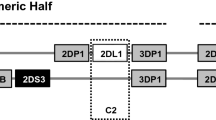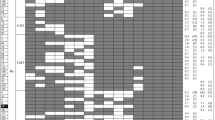Abstract
Killer cell immunoglobulin-like receptors (KIR) consists of activating and inhibitory genes are essential for natural killer cell education. To determine the association of KIRs with susceptibility to invasive Breast cancer (BC), genotyping of 16 KIRs was performed by sequence-specific primers-polymerase chain reaction in 226 confirmed cases of BC with defined estrogen receptor (ER), progesterone receptor (PR), and human epidermal growth factor 2 (HER2) status and 226 healthy controls (CNs). We observed a lower frequency of 2DL1 and 2DS4del along with increased frequency of 2DS4fl in cases compared to CNs. Further analysis revealed a higher frequency of KIR2DL2, 2DS1, 2DS2,3DS1 in ER+ cases, 2DL2, 2DL5 in PR+ and 2DL1 in HER2+ cases compared to CNs. The detrimental role of KIR2DS4fl was observed in ER+ and PR+ cases whereas 2DS4del confers protection against ER+, PR+, and HER2+ cases. We noted the predisposing role of Bx genotype, KIR2DS1, 2DS2, 2DS5, 2DL2, 2DL5 for lymphatic invasion in ER+ cases along with a higher rate of lymph node metastasis (LNM) in carriers of Bx genotype and KIR2DS1 in ER+ cases. We suggest a link between B haplotype associated genes with the increased risk of lymphatic invasion and LNM, particularly in ER+ cases of BC.
This is a preview of subscription content, access via your institution
Access options
Subscribe to this journal
Receive 6 digital issues and online access to articles
$119.00 per year
only $19.83 per issue
Buy this article
- Purchase on Springer Link
- Instant access to full article PDF
Prices may be subject to local taxes which are calculated during checkout
Similar content being viewed by others
References
Tyrer J, Duffy SW, Cuzick J. A breast cancer prediction model incorporating familial and personal risk factors. Stat Med. 2004;23:1111–30.
Kamińska M, Ciszewski T, Łopacka-Szatan K, Miotła P, Starosławska E. Breast cancer risk factors. Prz menopauzalny= Menopause Rev. 2015;14:196.
Feng Y, Spezia M, Huang S, Yuan C, Zeng Z, Zhang L, et al. Breast cancer development and progression: Risk factors, cancer stem cells, signaling pathways, genomics, and molecular pathogenesis. Genes Dis. 2018;5:77–106.
Harbeck N, Penault-Llorca F, Cortes J, Gnant M, Houssami N, Poortmans P, et al. Breast cancer. Nat Rev Dis Prim. 2019;5:66.
Saadatmand S, Bretveld R, Siesling S, Tilanus-Linthorst MM. Influence of tumour stage at breast cancer detection on survival in modern times: population based study in 173,797 patients. BMJ. 2015;351:h4901.
Dias AS, Almeida CR, Helguero LA, Duarte IF. Metabolic crosstalk in the breast cancer microenvironment. Eur J Cancer. 2019;121:154–71.
Pfeifer C, Highton AJ, Peine S, Sauter J, Schmidt AH, Bunders MJ, et al. Natural killer cell education is associated with a distinct metabolic profile. Front Immunol. 2018;9:3020.
Vivier E, Raulet DH, Moretta A, Caligiuri MA, Zitvogel L, Lanier LL, et al. Innate or adaptive immunity? The example of natural killer cells. Science. 2011;331:44–9.
Sternberg-Simon M, Brodin P, Pickman Y, Önfelt B, Kärre K, Malmberg K-J, et al. Natural killer cell inhibitory receptor expression in humans and mice: a closer look. Front Immunol. 2013;4:65.
Augusto DG. The impact of KIR polymorphism on the risk of developing cancer: not as strong as imagined? Front Genet. 2016;7:121.
Dorak MT. Role of natural killer cells and killer immunoglobulin-like receptor polymorphisms. Methods Mol. Med. 2007;134:123–44.
Pende D, Falco M, Vitale M, Cantoni C, Vitale C, Munari E et al. Killer Ig-like receptors (KIRs): their role in NK cell modulation and developments leading to their clinical exploitation. Front Immunol. 2019;10.
Rajalingam R. Diversity of killer cell immunoglobulin-like receptors and disease. Clin Lab Med. 2018;38:637–53.
Uhrberg M. The KIR gene family: life in the fast lane of evolution. Eur J Immunol. 2005;35:10–5.
Cooley S, Weisdorf DJ, Guethlein LA, Klein JP, Wang T, Le CT, et al. Donor selection for natural killer cell receptor genes leads to superior survival after unrelated transplantation for acute myelogenous leukemia. Blood. 2010;116:2411–9.
Middleton D, Gonzelez F. The extensive polymorphism of KIR genes. Immunology. 2010;129:8–19.
Ivarsson MA, Michaëlsson J, Fauriat C. Activating killer cell Ig-like receptors in health and disease. Front Immunol. 2014;5:184.
Rajagopalan S, Long EO. The direct binding of a p58 killer cell inhibitory receptor to human histocompatibility leukocyte antigen (HLA)-Cw4 exhibits peptide selectivity. J Exp Med. 1997;185:1523–8.
Boudreau JE, Hsu KC. Natural killer cell education in human health and disease. Curr Opin Immunol. 2018;50:102–11.
Ozturk OG, Gun FD, Polat G. Killer cell immunoglobulin-like receptor genes in patients with breast cancer. Med Oncol. 2012;29:511–5.
Alomar SY, Alkhuriji A, Trayhyrn P, Alhetheel A, Al-jurayyan A, Mansour L. Association of the genetic diversity of killer cell immunoglobulin-like receptor genes and HLA-C ligand in Saudi women with breast cancer. Immunogenetics. 2017;69:69–76.
Jobim MR, Jobim M, Salim PH, Portela P, Jobim LF, Leistner-Segal S, et al. Analysis of KIR gene frequencies and HLA class I genotypes in breast cancer and control group. Hum Immunol. 2013;74:1130–3.
Jamali E, Barani S, Yousefinejad F, Ariafar A, Talei GR, Ghaderi A. KIRs gene content diversity in Iranians with urothelial bladder cancer. Mol Biol Rep. 2018;45:713–9.
Yousefinejad F, Jowkar F, Barani S, Jamali E, Mahmoudi E, Ramezani A, et al. Killer cell immunoglobulin-like receptors (KIRs) genotype and haplotype analysis in iranians with non-melanoma skin cancers. Iran Biomed J. 2019;23:330.
Barani S, Taghipour M, Ghaderi AJI. Positive association of Bx genotype, KIR2L5, KIR2DS5 and full-length KIR2DS4 with the risk of meningioma. Immunobiology. 2020;225:151900.
Barani S, Hosseini SV, Ghaderi A. Activating and inhibitory killer cell immunoglobulin like receptors (KIR) genes are involved in an increased susceptibility to colorectal adenocarcinoma and protection against invasion and metastasis. Immunobiology. 2019;224:681–6.
Barani S, Khademi B, Ashouri E, Ghaderi A. KIR2DS1, 2DS5, 3DS1 and KIR2DL5 are associated with the risk of head and neck squamous cell carcinoma in Iranians. Hum Immunol. 2018;79:218–23.
Barani S, Khademi B, Ghaderi A. KIR2DS4, KIR2DL2, and KIR2DS4del are linked with basaloid tumors, lymph node metastasis, advanced stage and metastatic risk in head and neck squamous cell carcinoma. Exp Mol Pathol. 2020;112:104345.
Chavan VR, Chaudhari D, Ahir S, Ansari Z, Mehta P, Mania-Pramanik JJBri. Variations in KIR genes: a study in HIV-1 serodiscordant couples. Biomed Res Int. 2014;2014:891402.
Giebel S, Nowak I, Wojnar J, Krawczyk-Kulis M, Holowiecki J, Kyrcz-Krzemien S, et al. Association of KIR2DS4 and its variant KIR1D with leukemia. Leukemia. 2008;22:2129.
Bao X, Hou L, Sun A, Qiu Q, Yuan X, Chen M, et al. The impact of KIR2DS4 alleles and the expression of KIR in the development of acute GVHD after unrelated allogeneic hematopoietic SCT. Bone Marrow Transpl. 2010;45:1435.
Deng Z, Zhao J, Cai S, Qi Y, Yu Q, Martin MP, et al. Natural killer cells offer differential protection from three kinds of leukemia in southern Chinese Han. Front Immunol. 2019;10:1646.
La Nasa G, Greco M, Littera R, Oppi S, Celeghini I, Caria R, et al. The favorable role of homozygosity for killer immunoglobulin-like receptor (KIR) A haplotype in patients with advanced-stage classic Hodgkin lymphoma. J Hematol. 2016;9:26.
Perez M, Cabrera T, Lopez Nevot M, Gomez M, Peran F, Ruiz‐Cabello F, et al. Heterogeneity of the expression of class I and II HLA antigens in human breast carcinoma. Int J Immunogenetics. 1986;13:247–54.
Wintzer H, Benzing M, Von Kleist S. Lacking prognostic significance of β 2-microglobulin, MHC class I and class II antigen expression in breast carcinomas. Br J cancer. 1990;62:289.
Fleming K, McMichael A, Morton J, Woods J, McGee JOD. Distribution of HLA class 1 antigens in normal human tissue and in mammary cancer. J Clin Pathol. 1981;34:779–84.
Hernandez EG, Partida-Rodriguez O, Camorlinga-Ponce M, Nieves-Ramirez M, Ramos-Vega I, Torres J, et al. Genotype B of killer cell immunoglobulin-like receptor is related with gastric cancer lesions. Sci Rep. 2018;8:6104.
Rajalingam R. Human diversity of killer cell immunoglobulin-like receptors and disease. Korean J Hematol. 2011;46:216–28.
Mamessier E, Sylvain A, Thibult M-L, Houvenaeghel G, Jacquemier J, Castellano R, et al. Human breast cancer cells enhance self tolerance by promoting evasion from NK cell antitumor immunity. J Clin Investig. 2011;121:3609–22.
Kristensen AB, Kent SJ, Parsons MS. Contribution of NK cell education to both direct and anti-HIV-1 antibody-dependent NK cell functions. J Virol. 2018;92:e02146–17.
Bao X, Wang M, Zhou H, Zhang H, Wu X, Yuan X, et al. Donor killer immunoglobulin-like receptor profile Bx1 imparts a negative effect and centromeric B-specific gene motifs render a positive effect on standard-risk acute myeloid leukemia/myelodysplastic syndrome patient survival after unrelated donor hematopoietic stem cell transplantation. Biol Blood Marrow Transpl. 2016;22:232–9.
Levinson RD, Yung M, Meguro A, Ashouri E, Yu F, Mizuki N, et al. KIR and HLA genotypes implicated in reduced killer lymphocytes immunity are associated with Vogt-Koyanagi-Harada disease. PloS ONE. 2016;11:e0160392.
Zhuang Y, Song Y, Zhu C, Zhang Y, Wang D, Nie X, et al. Association of KIR genotypes and haplotypes with syphilis in a Chinese Han population. Scand J Immunol. 2012;75:361–7.
Stern M, Hadaya K, Hönger G, Martin PY, Steiger J, Hess C, et al. Telomeric rather than centromeric activating KIR genes protect from cytomegalovirus infection after kidney transplantation. Am J Transplant. 2011;11:1302–7.
Klein SL, Flanagan KL. Sex differences in immune responses. Nat Rev Immunol. 2016;16:626.
Segovia-Mendoza M, Morales-Montor J. Immune tumor microenvironment in breast cancer and the participation of estrogens and its receptors into cancer physiopathology. Front Immunol. 2019;10:348.
Lee HJ, Song IH, Park IA, Heo S-H, Kim Y-A, Ahn J-H, et al. Differential expression of major histocompatibility complex class I in subtypes of breast cancer is associated with estrogen receptor and interferon signaling. Oncotarget. 2016;7:30119.
Vilches C, Castano J, Gomez‐Lozano N, Estefania E. Facilitation of KIR genotyping by a PCR‐SSP method that amplifies short DNA fragments. Tissue Antigens. 2007;70:415–22.
Ashouri E, Ghaderi A, Reed E, Rajalingam R. A novel duplex SSP–PCR typing method for KIR gene profiling. Tissue Antigens. 2009;74:62–7.
Acknowledgements
The study was financially supported by Shiraz University of Medical Sciences [grant number: 1396-01-01-16590] and partly by Shiraz Institute for Cancer Research [grant number: ICR-100-509]. Ethical approval of the research was confirmed by Medical Ethics Committee of Shiraz University of Medical Sciences [IR.SUMS.REC.1397.573]. The present study was part of a MSc thesis written by Marjan Hematian Larki.
Author information
Authors and Affiliations
Corresponding author
Ethics declarations
Conflict of interest
The authors declare that they have no conflict of interest.
Additional information
Publisher’s note Springer Nature remains neutral with regard to jurisdictional claims in published maps and institutional affiliations.
Rights and permissions
About this article
Cite this article
Hematian Larki, M., Barani, S., Talei, AR. et al. Diversity of KIRs in invasive breast cancer patients and healthy controls along with the clinical significance in ER/PR/HER2+ patients. Genes Immun 21, 380–389 (2020). https://doi.org/10.1038/s41435-020-00117-1
Received:
Revised:
Accepted:
Published:
Issue Date:
DOI: https://doi.org/10.1038/s41435-020-00117-1
This article is cited by
-
KIR-HLA gene diversities and susceptibility to lung cancer
Scientific Reports (2022)
-
Coexistence of inhibitory and activating killer-cell immunoglobulin-like receptors to the same cognate HLA-C2 and Bw4 ligands confer breast cancer risk
Scientific Reports (2021)



